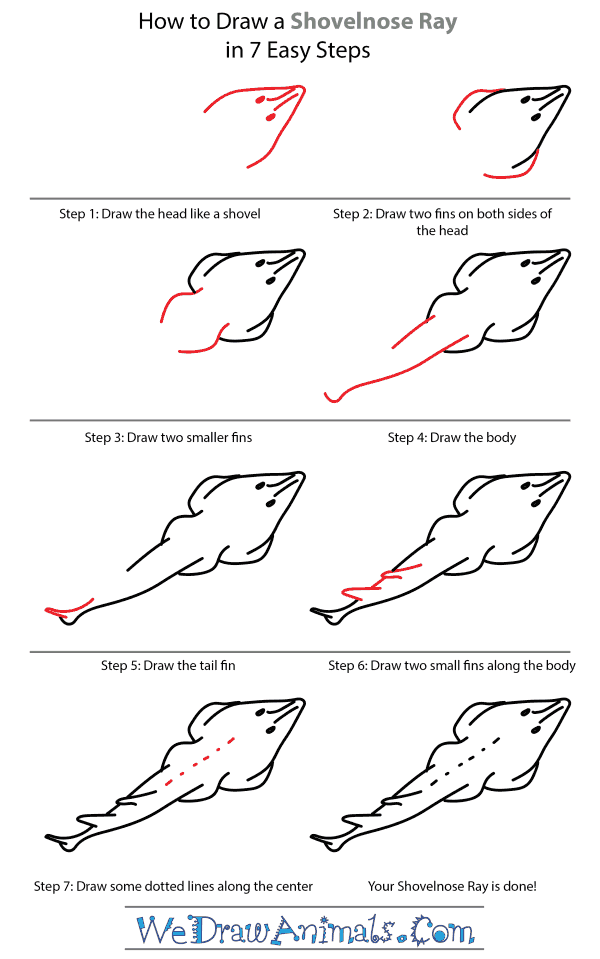In this quick tutorial you'll learn how to draw a Shovelnose Ray in 7 easy steps - great for kids and novice artists.
The images above represent how your finished drawing is going to look and the steps involved.
Below are the individual steps - you can click on each one for a High Resolution printable PDF version.
At the bottom you can read some interesting facts about the Shovelnose Ray.
Make sure you also check out any of the hundreds of drawing tutorials grouped by category.
How to Draw a Shovelnose Ray - Step-by-Step Tutorial
Step 1: Draw a curved triangle looking shape, add two lines for definition and dots for eyes. This will form the head
Step 2: Draw a curved fin on either side of the head
Step 3: Draw two smaller fins inside of them to begin the body
Step 4: Draw two lines for the rest of the body
Step 5: Add a tiny, curved line for the tailfin
Step 6: Draw two smaller tailfins along the top part of the body
Step 7: Draw some dotted lines along the center to simulate more fins
Interesting Facts about the Shovelnose Ray
This ray, also known as the Giant Shovelnose Ray or the Common Shovelnose Ray, is a common commercial find for fishermen in Asia. They are often caught unintentionally as a bycatch when fishers are trying to retrieve other species of fish from the waters. Not much is known about the population of this fish, but it is classed as vulnerable to endangerment because of the fishing practices that have undoubtedly thinned their numbers. Because the fins and the flesh of this fish sell for fairly high prices in some parts of Asia, it is not at all uncommon for fishermen to intentionally pull up the shovelnose ray to sell. This fish is a perfect example of how over-fishing can damage species populations immensely, even when it is not done on purpose.
Did you know?
- Adults grow to at least 270 centimeters in length.
- Males and females both mature at around 155 centimeters to 175 centimeters.
- The young of this species are significantly smaller than the adults, born between 38 and 48 centimeters.
- The shovelnose ray preys upon small crustaceans, blue swimmer crabs and king prawn.
- Newborn rays will be born throughout the year. It doesn’t seem that the shovelnose ray has a specific breeding season.
This species of fish is often found in the Pacific and Indian oceans, around many locations including Bangladesh, Sri Lanka, Australia and Indonesia. Adults can usually be found in waters up to 100 meters in depth, and can live in one place permanently for as long as they have access to freshwater. Immature shovelnose rays will use shallow sand flats as a place to relax, and then will move in to feed when the high tide comes rolling in.








